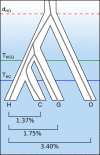Insights into hominid evolution from the gorilla genome sequence
- PMID: 22398555
- PMCID: PMC3303130
- DOI: 10.1038/nature10842
Insights into hominid evolution from the gorilla genome sequence
Abstract
Gorillas are humans' closest living relatives after chimpanzees, and are of comparable importance for the study of human origins and evolution. Here we present the assembly and analysis of a genome sequence for the western lowland gorilla, and compare the whole genomes of all extant great ape genera. We propose a synthesis of genetic and fossil evidence consistent with placing the human-chimpanzee and human-chimpanzee-gorilla speciation events at approximately 6 and 10 million years ago. In 30% of the genome, gorilla is closer to human or chimpanzee than the latter are to each other; this is rarer around coding genes, indicating pervasive selection throughout great ape evolution, and has functional consequences in gene expression. A comparison of protein coding genes reveals approximately 500 genes showing accelerated evolution on each of the gorilla, human and chimpanzee lineages, and evidence for parallel acceleration, particularly of genes involved in hearing. We also compare the western and eastern gorilla species, estimating an average sequence divergence time 1.75 million years ago, but with evidence for more recent genetic exchange and a population bottleneck in the eastern species. The use of the genome sequence in these and future analyses will promote a deeper understanding of great ape biology and evolution.
Figures











Comment in
-
Genomics: Gorilla gorilla gorilla.Nature. 2012 Mar 7;483(7388):164-5. doi: 10.1038/483164a. Nature. 2012. PMID: 22398552 Free PMC article. No abstract available.
References
-
- Huxley TH. Evidence as to Man’s Place in Nature. Williams & Norgate; 1863.
-
- King MC, Wilson AC. Evolution at two levels in humans and chimpanzees. Science. 1975;188:107–116. - PubMed
-
- ChimpanzeeSequencingandAnalysisConsortium Initial sequence of the chimpanzee genome and comparison with the human genome. Nature. 2005;437:69–87. doi:10.1038/nature04072. - PubMed
Publication types
MeSH terms
Substances
Associated data
- Actions
- Actions
- Actions
- Actions
- Actions
- Actions
- Actions
- Actions
- Actions
- Actions
- Actions
- Actions
- Actions
- Actions
- Actions
- Actions
- Actions
- Actions
- Actions
- Actions
- Actions
- Actions
- Actions
- Actions
- Actions
- Actions
- Actions
Grants and funding
- G0501331/MRC_/Medical Research Council/United Kingdom
- 075491/Z/04/WT_/Wellcome Trust/United Kingdom
- G0701805/MRC_/Medical Research Council/United Kingdom
- 202218/ERC_/European Research Council/International
- 089066/WT_/Wellcome Trust/United Kingdom
- HG002385/HG/NHGRI NIH HHS/United States
- U54 HG003079/HG/NHGRI NIH HHS/United States
- 062023/WT_/Wellcome Trust/United Kingdom
- R01 HG002385/HG/NHGRI NIH HHS/United States
- A15603/CRUK_/Cancer Research UK/United Kingdom
- 077009/WT_/Wellcome Trust/United Kingdom
- 077192/WT_/Wellcome Trust/United Kingdom
- HHMI/Howard Hughes Medical Institute/United States
- BB_/Biotechnology and Biological Sciences Research Council/United Kingdom
- 090532/WT_/Wellcome Trust/United Kingdom
- 095908/WT_/Wellcome Trust/United Kingdom
- 15603/CRUK_/Cancer Research UK/United Kingdom
- 077198/WT_/Wellcome Trust/United Kingdom
- ImNIH/Intramural NIH HHS/United States
LinkOut - more resources
Full Text Sources
Other Literature Sources
Molecular Biology Databases
Research Materials
Miscellaneous

